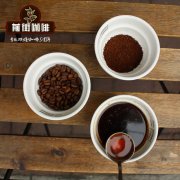What is the principle of aerobic fermentation and anaerobic fermentation of coffee beans? What is the fermentation of coffee bean red wine?

Professional coffee knowledge exchange more coffee bean information please follow the coffee workshop (Wechat official account cafe_style)
What is the principle of aerobic fermentation and anaerobic fermentation of coffee beans? What is the principle of coffee bean red wine treatment and fermentation?
Aerobic fermentation can make the yeast produce more gas and the ratio of bread to bread is high, but the anaerobic fermentation should be properly controlled to make the product full of flavor.
The alcohol converted in anoxic fermentation and the organic acids in the dough will form esters in the baking process.
The peculiar fermentation flavor of the product. )
How to create aerobic conditions? Rub more in the general way? Fold fully many times in the kneading-free method? How to create anoxic conditions? Sealed fermentation? Less rubbing?]
Great! It's a good question. In most of the courses I hear, all I often talk about is fold. Many experienced chefs will tell you how often to turn and just do it. They seldom delve into the principle of this step. Some even boast that their dough is completely fermented in an aerobic environment and has an excellent flavor.
I admire you very much. You get to the center of the problem and go deep into the world of yeast.
First of all, let's understand what is aerobic fermentation and what is anaerobic fermentation:
Yeast basically belongs to facultative anaerobic organisms, the so-called facultative anaerobic organisms, which means that they can survive in an aerobic environment, carry out aerobic respiration in an aerobic environment, and Fermentation in an anaerobic environment. Fermentation is not exclusive to yeast, including lactic acid bacteria and acetic acid bacteria.
The so-called aerobic fermentation, the more correct term should be respiration, there is no fermentation process, burning sugars in an aerobic environment emits carbon dioxide and produces energy.
To put it simply, such as the chemical formula in high school biology textbooks: C6H12O6 + 6O → 6 CO2 + 6H2O
Fermentation (fermentation) performed in an anaerobic environment, taking lactic acid bacteria and acetic acid bacteria as examples:
C 6 H 12 O 6 + 2 ADP + 2 phosphate → 2 lactic acid + 2 ATP
C 6 H 12 O 6 + 2 ADP + 2 phosphate → 2 C 2 H 5 OH + 2 CO 2 ↑ + 2 ATP
The energy produced by respiration is much higher than that of fermentation, and the relative exhaust volume of CO 2 is also higher than that of fermentation. however, yeast is exhaling.
The process of absorption does not produce alcohol or other special chemicals, which are produced during fermentation in an oxygen-free environment.
If we use baking language, it is "special flavor". There are many kinds of yeast, and each kind of yeast has its own special style.
Taste, this part, is worthy of in-depth discussion.
(I would like to digress here. We often use the phrase "natural yeast". In fact, all yeasts are natural, but some of them are purified and replicated in large quantities. We call them industrial yeasts and get them everywhere (for example, raisins, apples, etc.). Rye, Duran wheat... We call it natural yeast. I think it is more appropriate to call it wild yeast. Just like cattle, we will divide it into two categories: captive breeding and wild release.
Answer the question. )
Of course, different environment and temperature will affect the breeding generation of yeast, and the length of each generation is related to the environment and temperature.
The length of reproductive generation is directly related to the amount of CO-2 excreted.
-
CO 2 expands when it is heated, and the size of the stomata is directly related to the amount of carbon dioxide, but the air that expands is not just two.
Carbon oxide, molecules in the air, and the degree of disorder after heating (entropy (entropy)) will all increase. The size of the stomata is determined by the size of the pores.
The amount of air and Glutenin to form the thickness of the film and gelatinization (Viscosity), both form a schedule competition, generally I
They are used in bread that needs stomata (Baguette, Cibatta,. Etc.)
But if we try to create an aerobic environment, accelerate yeast exhaust, and pursue the results of stomatal, relatively, aerobic respiration.
It will lose a lot of flavor, that is to say, the reason why atmospheric holes are not necessarily delicious is here. I have seen some Japanese and Vietnamese French noodles.
Bag, this is the case.
In order to achieve the characteristics of breathing and fermentation at the same time, experienced bakers will wisely use temperature and fold times to adjust.
The former, in the absence of oxygen, the yeast executes fermentation to produce the desired flavor, and at the same time uses the temperature to control the yeast.
The working temperature of bacteria, lactic acid bacteria and acetic acid bacteria (this part I have explained to you in detail in my last letter, you can refer to it)
Of course, in the process, we can solidify the PH value. In addition, there is a very important concept, that is, the use of temperature to control the yeast
Breeding generations, so that hydration has plenty of time to carry out, this part you can learn more about the hyadration process, fermentation
The role played by Su, many experienced masters, will tell you to use autolyze to have enzymes break down amylose into monosaccharides.
2015 WBC contestant Sasa brought to the world a Colombian coffee bean that has gone through a similar wine-making process. In addition to the novel taste of beans, the "red wine treatment" that was adopted to treat beans also made editors as curious as many coffee lovers. What on earth is the so-called "red wine treatment"? I believe we all know the traditional coffee treatment methods such as washing, tanning and honey treatment, but what is the red wine treatment of coffee beans?
The red wine treatment of coffee beans, also known as red wine treatment, is inspired by the brewing technology of red wine. At present, only eight estates in Colombia have successfully introduced coffee beans treated with this method to the market. According to the data of these eight estates, we can roughly divide the types of red wine treatment into: acetic acid fermentation (Aerobic aerobic fermentation), lactic acid fermentation (Anaerobuic anaerobic fermentation), mixed fermentation (Mix Fermentation=Aerobic+Anaerobuic).
The traditional treatment method is difficult to control the changeable fermentation degree of coffee beans. But red wine treatment rules can ensure the quality of coffee beans by controlling PH value, even temperature and humidity, and airtight fermentation makes aroma less volatile.
The red wine treatment of coffee beans, also known as red wine treatment, is inspired by the brewing technology of red wine. At present, only eight estates in Colombia have successfully introduced coffee beans treated with this method to the market. According to the data of these eight estates, we can roughly divide the types of red wine treatment into: acetic acid fermentation (Aerobic aerobic fermentation), lactic acid fermentation (Anaerobuic anaerobic fermentation), mixed fermentation (Mix Fermentation=Aerobic+Anaerobuic).
The traditional treatment method is difficult to control the changeable fermentation degree of coffee beans. But red wine treatment rules can ensure the quality of coffee beans by controlling PH value, even temperature and humidity, and airtight fermentation makes aroma less volatile.
Next, let's talk about the specific process of fermentation. First of all, Colombian farmers carefully pick coffee cherries and carefully select coffee red fruits to ensure that among the coffee cherries selected for processing, the percentage of immature cherries is less than 2%, defective beans less than 3%, and floating beans less than 5%.
The selected coffee cherries are placed in a specific container by the farmer's uncle (the beans used by Australian baristas in the Sasa competition are placed in metal containers). But in any case, the container should have a device similar to a red wine fermentation suppository or a single exhaust valve. In this way, carbon dioxide can be spilled through the device to control the concentration of air in the container. At this time, the coffee cherries in the container are fermented with acetic acid, and the beans are relatively bright, clean and citric acid.
According to Sasa's description in the competition, the processor injected carbon dioxide into the container to prevent oxidation from producing volatile acid, a process known as lactic acid fermentation, which produces malic acid and stone acid, which is relatively stable, so the beans fermented with lactic acid have a more mellow acidity, with cheese, nutty and creamy flavor.
As for the description of the difference between water and no water in the treatment of red wine, the editor is still in distress. The above contents still need to be considered, I hope you will discuss it more!
Before writing this article, the editor looked through all the data on the red wine-treated estates in Columbia, analyzed Sasa's description of the beans he chose during the competition, and looked at the mechanism of fruit fermentation in biology. Even so, there is still no detailed description in the data, including the official website description of the bean manor is only limited to the flavor. It is believed that this new way of handling is still in a state of secrecy and has not been popularized. of course, there is no comment.
Even though the details of red wine treatment are not known, the editor roughly summarizes the process description of "red wine treatment" by combining the consultation mentioned above and his own understanding of the wine fermentation process.
Important Notice :
前街咖啡 FrontStreet Coffee has moved to new addredd:
FrontStreet Coffee Address: 315,Donghua East Road,GuangZhou
Tel:020 38364473
- Prev

Flavor and characteristics of Yelsa Farm Yellow Honey treatment in Yelsalo Manor, Costa Rica? Pressure generation
Professional coffee knowledge exchange more coffee bean information please pay attention to the coffee workshop (Wechat official account cafe_style) Costa Rica Yesaro estate Yelsa processing farm yellow honey processing flavor and characteristics? What is the principle of yellow honey? Costa Rica's famous Yelsa treatment plant (Helsar de Zarcero), established in 2004, has repeatedly won the extraordinary Cup (cup)
- Next

What exactly does Dan Mengqi coffee mean _ 90+Levelup Dan Mengqi coffee flavor characteristics
Professional coffee knowledge exchange more coffee bean information please follow the coffee workshop (Wechat official account cafe_style) Level up Danqi Meng Coffee means Perfect approach, from Yega Xuefei Jinlena Anbaya Supervisor Menso small Farmers, products launched against the background of Ninety Plus's professional flavor process. Danch Meng means Good Aproach in Sidamo.
Related
- Detailed explanation of Jadeite planting Land in Panamanian Jadeite Manor introduction to the grading system of Jadeite competitive bidding, Red bid, Green bid and Rose Summer
- Story of Coffee planting in Brenka region of Costa Rica Stonehenge Manor anaerobic heavy honey treatment of flavor mouth
- What's on the barrel of Blue Mountain Coffee beans?
- Can American coffee also pull flowers? How to use hot American style to pull out a good-looking pattern?
- Can you make a cold extract with coffee beans? What is the right proportion for cold-extracted coffee formula?
- Indonesian PWN Gold Mandrine Coffee Origin Features Flavor How to Chong? Mandolin coffee is American.
- A brief introduction to the flavor characteristics of Brazilian yellow bourbon coffee beans
- What is the effect of different water quality on the flavor of cold-extracted coffee? What kind of water is best for brewing coffee?
- Why do you think of Rose Summer whenever you mention Panamanian coffee?
- Introduction to the characteristics of authentic blue mountain coffee bean producing areas? What is the CIB Coffee Authority in Jamaica?

